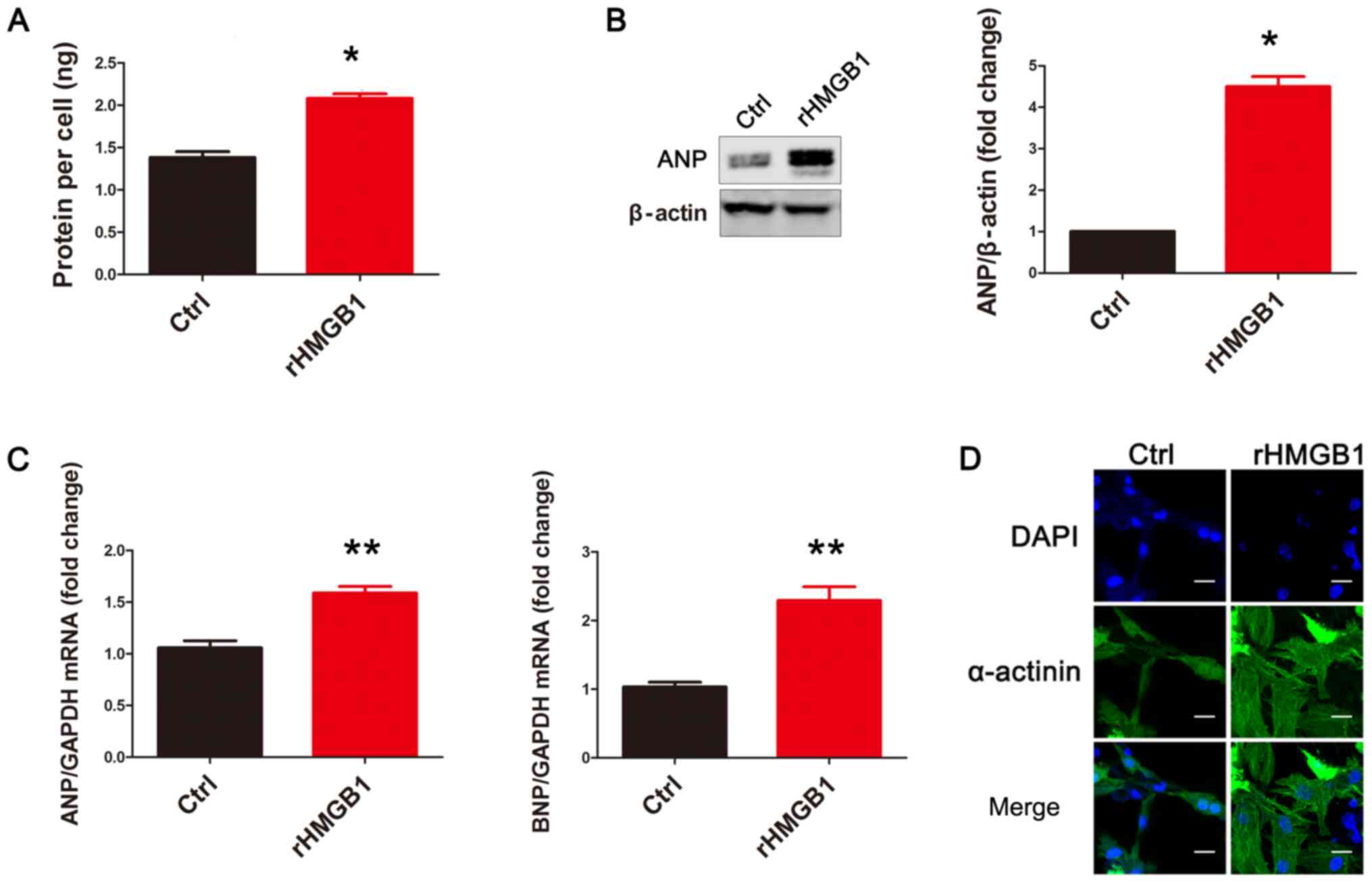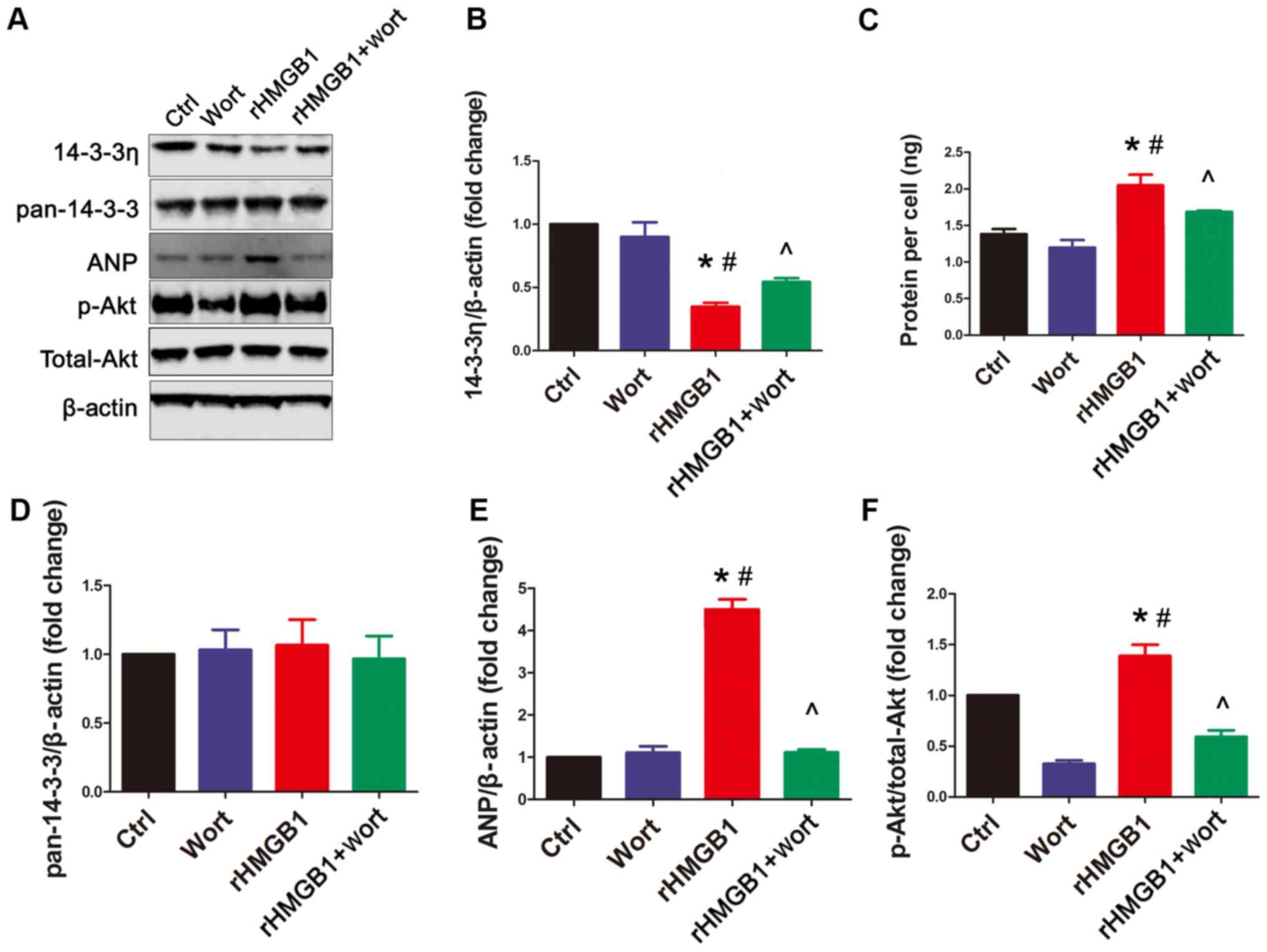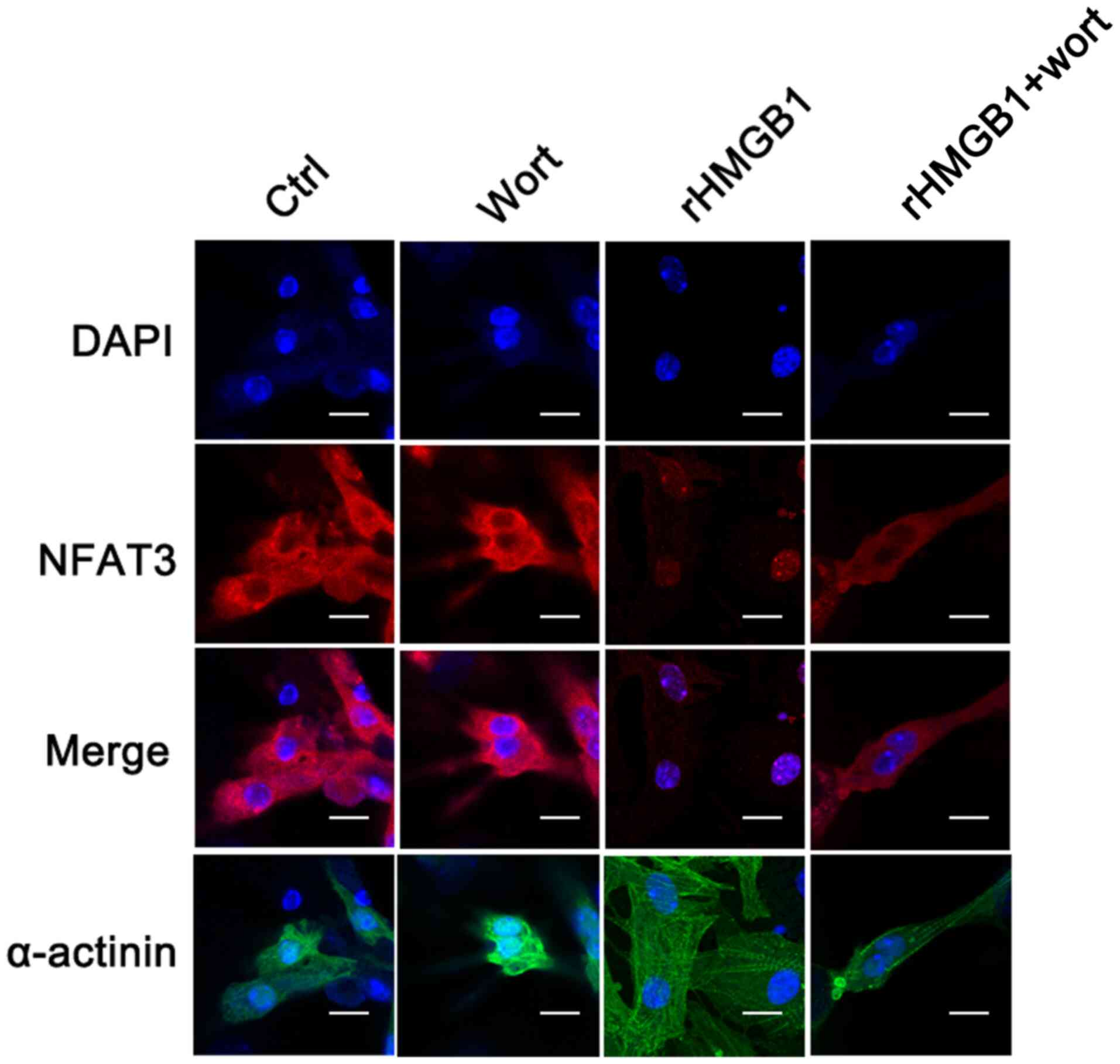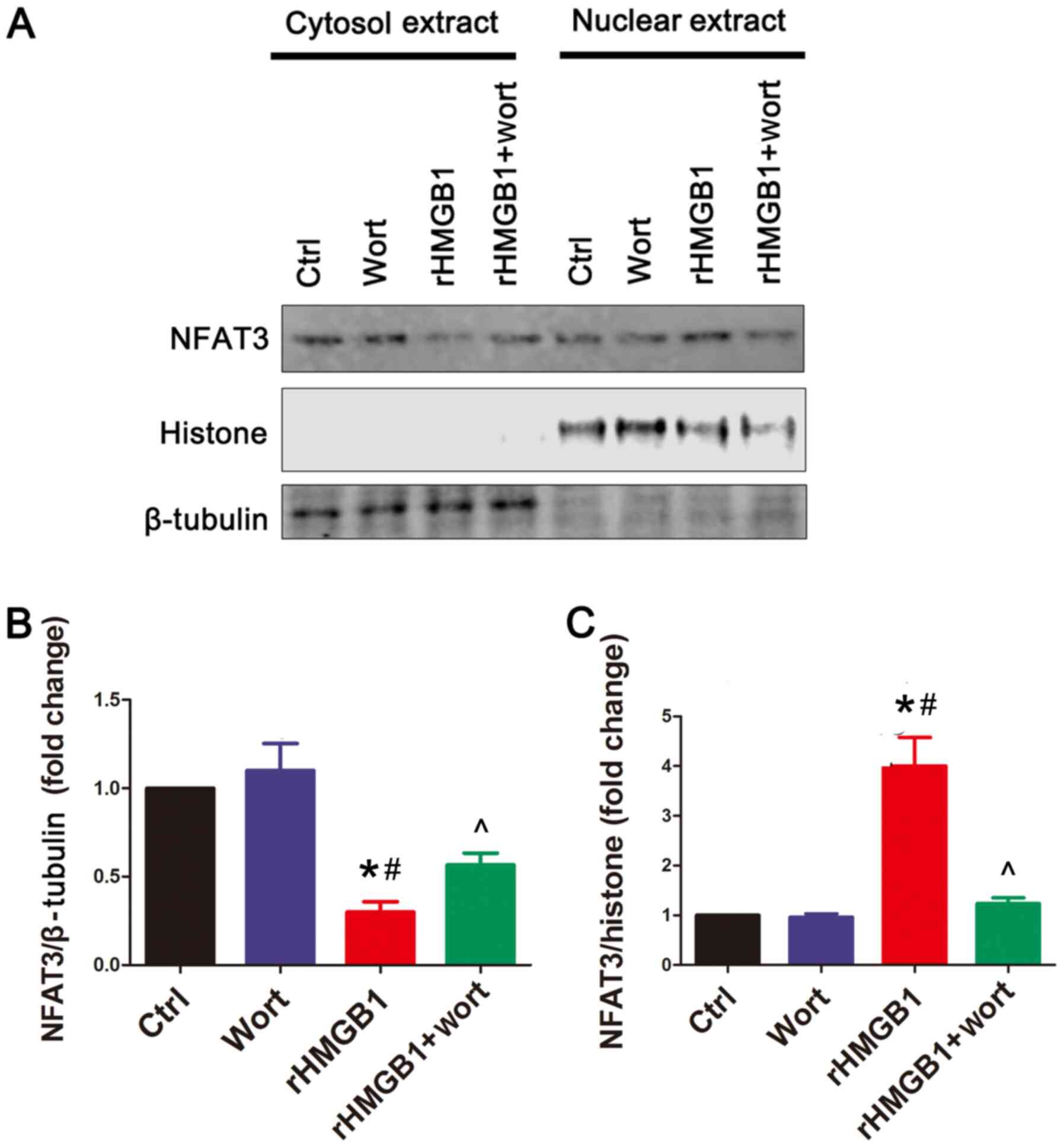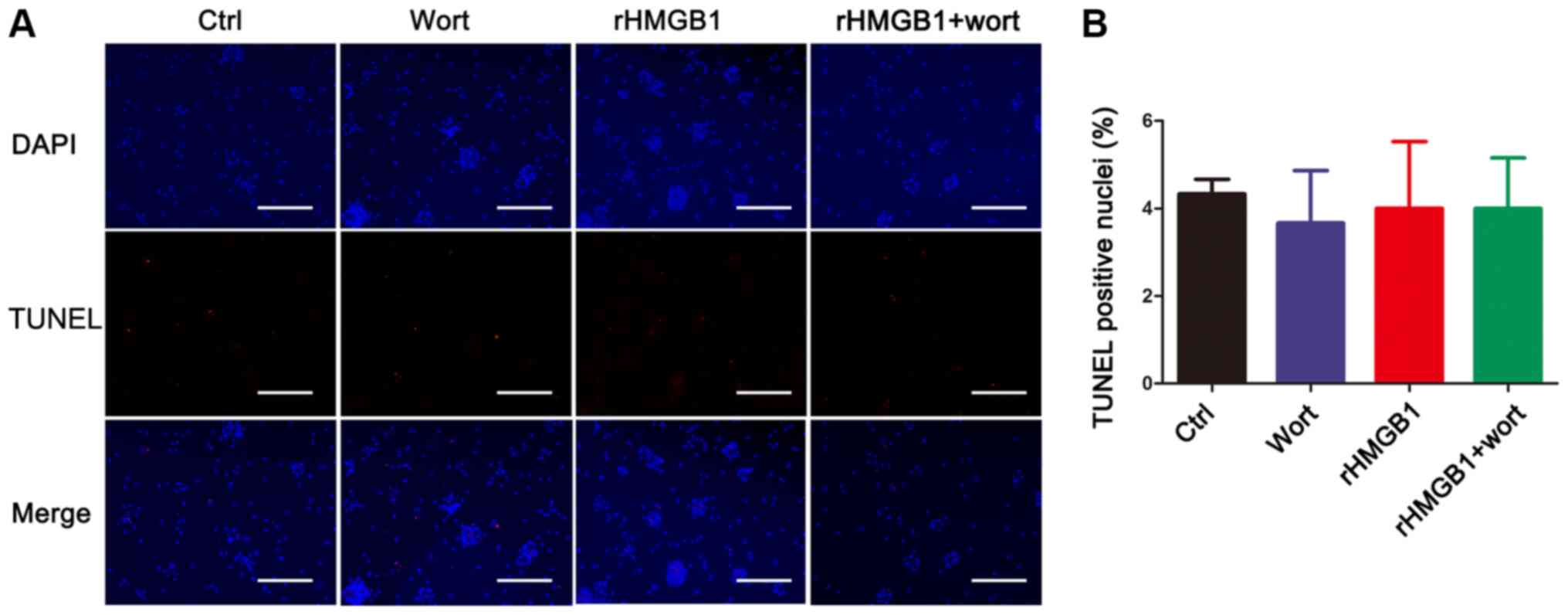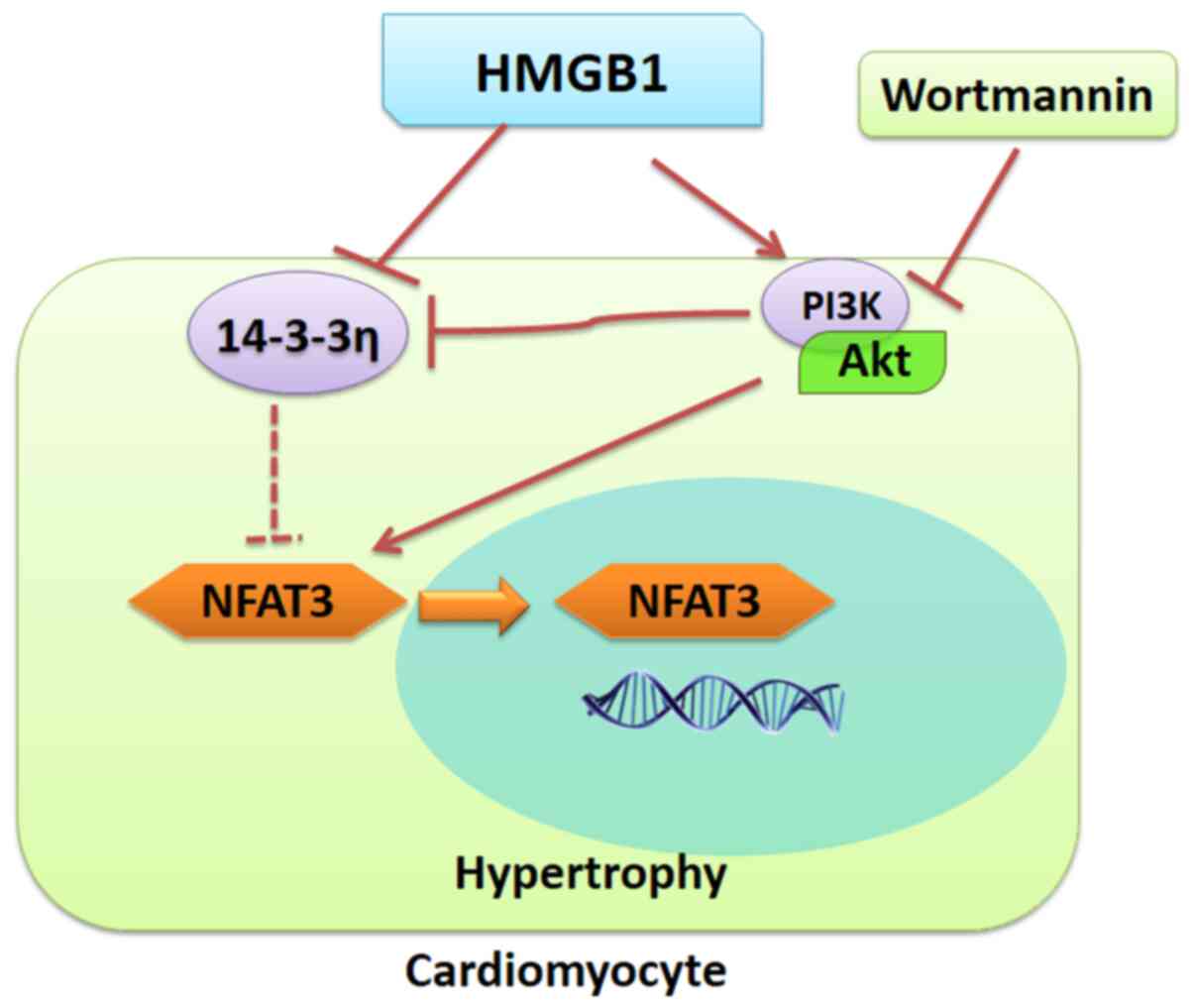|
1
|
Biscetti F, Flex A, Alivernini S, Tolusso
B, Gremese E and Ferraccioli G: The role of high-mobility group
Box-1 and its crosstalk with microbiome in rheumatoid arthritis.
Mediators Inflamm. 2017:52303742017. View Article : Google Scholar : PubMed/NCBI
|
|
2
|
Bangert A, Andrassy M, Muller AM,
Bockstahler M, Fischer A, Volz CH, Leib C, Göser S, Korkmaz-Icöz S,
Zittrich S, et al: Critical role of RAGE and HMGB1 in inflammatory
heart disease. Proc Natl Acad Sci USA. 113:E155–E164. 2016.
View Article : Google Scholar : PubMed/NCBI
|
|
3
|
Dong LY, Chen F, Xu M, Yao LP, Zhang YJ
and Zhuang Y: Quercetin attenuates myocardial ischemia-reperfusion
injury via downregulation of the HMGB1-TLR4-NF-kB signaling
pathway. Am J Transl Res. 10:1273–1283. 2018.PubMed/NCBI
|
|
4
|
Zhang W, Tao A, Lan T, Cepinskas G, Kao R,
Martin CM and Rui T: Carbon monoxide releasing molecule-3 improves
myocardial function in mice with sepsis by inhibiting NLRP3
inflammasome activation in cardiac fibroblasts. Basic Res Cardiol.
112:162017. View Article : Google Scholar : PubMed/NCBI
|
|
5
|
Wu RN, Yu TY, Zhou JC, Li M, Gao HK, Zhao
C, Dong RQ, Peng D, Hu ZW, Zhang XW and Wu YQ: Targeting HMGB1
ameliorates cardiac fibrosis through restoring TLR2-mediated
autophagy suppression in myocardial fibroblasts. Int J Cardiol.
267:156–162. 2018. View Article : Google Scholar : PubMed/NCBI
|
|
6
|
Shen W, Zhou J, Wang C, Xu G, Wu Y and Hu
Z: High mobility group box 1 induces calcification of aortic valve
interstitial cells via toll-like receptor 4. Mol Med Rep.
15:2530–2536. 2017. View Article : Google Scholar : PubMed/NCBI
|
|
7
|
Lv Q, Li C, Mo Y and He L: The role of
HMGB1 in heart transplantation. Immunol Lett. 194:1–3. 2018.
View Article : Google Scholar : PubMed/NCBI
|
|
8
|
Su FF, Shi MQ, Guo WG, Liu XT, Wang HT, Lu
ZF and Zheng QS: High-mobility group box 1 induces
calcineurin-mediated cell hypertrophy in neonatal rat ventricular
myocytes. Mediators Inflamm. 2012:8051492012. View Article : Google Scholar : PubMed/NCBI
|
|
9
|
Nehra S, Bhardwaj V, Kalra N, Ganju L,
Bansal A, Saxena S and Saraswat D: Nanocurcumin protects
cardiomyoblasts H9c2 from hypoxia-induced hypertrophy and apoptosis
by improving oxidative balance. J Physiol Biochem. 71:239–251.
2015. View Article : Google Scholar : PubMed/NCBI
|
|
10
|
Fang X, Liu Y, Lu J, Hong H, Yuan J, Zhang
Y, Wang P, Liu P and Ye J: Protocatechuic aldehyde protects against
isoproterenol-induced cardiac hypertrophy via inhibition of the
JAK2/STAT3 signaling pathway. Naunyn Schmiedebergs Arch Pharmacol.
391:1373–1385. 2018. View Article : Google Scholar : PubMed/NCBI
|
|
11
|
Wang S, Han HM, Pan ZW, Hang PZ, Sun LH,
Jiang YN, Song HX, Du ZM and Liu Y: Choline inhibits angiotensin
II-induced cardiac hypertrophy by intracellular calcium signal and
p38 MAPK pathway. Naunyn Schmiedebergs Arch Pharmacol. 385:823–831.
2012. View Article : Google Scholar : PubMed/NCBI
|
|
12
|
Zwadlo C, Schmidtmann E, Szaroszyk M,
Kattih B, Froese N, Hinz H, Schmitto JD, Widder J, Batkai S, Bähre
H, et al: Antiandrogenic therapy with finasteride attenuates
cardiac hypertrophy and left ventricular dysfunction. Circulation.
131:1071–1081. 2015. View Article : Google Scholar : PubMed/NCBI
|
|
13
|
Song L, Wang L, Li F, Yukht A, Qin M,
Ruther H, Yang M, Chaux A, Shah PK and Sharifi BG: Bone
marrow-derived tenascin-C attenuates cardiac hypertrophy by
controlling inflammation. J Am Coll Cardiol. 70:1601–1615. 2017.
View Article : Google Scholar : PubMed/NCBI
|
|
14
|
Gendy AM, Abdallah DM and El-Abhar HS: The
potential curative effect of rebamipide in hepatic
ischemia/reperfusion injury. Naunyn Schmiedebergs Arch Pharmacol.
390:691–700. 2017. View Article : Google Scholar : PubMed/NCBI
|
|
15
|
Raucci A, Di Maggio S, Scavello F,
D'Ambrosio A, Bianchi ME and Capogrossi MC: The Janus face of HMGB1
in heart disease: A necessary update. Cell Mol Life Sci.
76:211–229. 2019. View Article : Google Scholar : PubMed/NCBI
|
|
16
|
Foglio E, Puddighinu G, Germani A, Russo
MA and Limana F: HMGB1 inhibits apoptosis following MI and induces
autophagy via mTORC1 inhibition. J Cell Physiol. 232:1135–1143.
2017. View Article : Google Scholar : PubMed/NCBI
|
|
17
|
Zhang L, Liu M, Jiang H, Yu Y, Yu P, Tong
R, Wu J, Zhang S, Yao K, Zou Y and Ge J: Extracellular
high-mobility group box 1 mediates pressure overload-induced
cardiac hypertrophy and heart failure. J Cell Mol Med. 20:459–470.
2016. View Article : Google Scholar : PubMed/NCBI
|
|
18
|
Funayama A, Shishido T, Netsu S, Narumi T,
Kadowaki S, Takahashi H, Miyamoto T, Watanabe T, Woo CH, Abe J, et
al: Cardiac nuclear high mobility group box 1 prevents the
development of cardiac hypertrophy and heart failure. Cardiovasc
Res. 99:657–664. 2013. View Article : Google Scholar : PubMed/NCBI
|
|
19
|
Liao W, Wang S, Han C and Zhang Y: 14-3-3
proteins regulate glycogen synthase 3beta phosphorylation and
inhibit cardiomyocyte hypertrophy. FEBS J. 272:1845–1854. 2005.
View Article : Google Scholar : PubMed/NCBI
|
|
20
|
Jia H, Liang Z, Zhang X, Wang J, Xu W and
Qian H: 14-3-3 proteins: An important regulator of autophagy in
diseases. Am J Transl Res. 9:4738–4746. 2017.PubMed/NCBI
|
|
21
|
Obsilova V, Kopecka M, Kosek D, Kacirova
M, Kylarova S, Rezabkova L and Obsil T: Mechanisms of the 14-3-3
protein function: Regulation of protein function through
conformational modulation. Physiol Res. 63 (Suppl 1):S155–S164.
2014. View Article : Google Scholar : PubMed/NCBI
|
|
22
|
Sreedhar R, Arumugam S, Thandavarayan RA,
Karuppagounder V, Koga Y, Nakamura T, Harima M and Watanabe K: Role
of 14-3-3 η protein on cardiac fatty acid metabolism and macrophage
polarization after high fat diet induced type 2 diabetes mellitus.
Int J Biochem Cell Biol. 88:92–99. 2017. View Article : Google Scholar : PubMed/NCBI
|
|
23
|
Sreedhar R, Arumugam S, Thandavarayan RA,
Giridharan VV, Karuppagounder V, Pitchaimani V, Afrin R, Miyashita
S, Nomoto M, Harima M, et al: Myocardial 14-3-3 η protein protects
against mitochondria mediated apoptosis. Cell Signal. 27:770–776.
2015. View Article : Google Scholar : PubMed/NCBI
|
|
24
|
Sreedhar R, Arumugam S, Thandavarayan RA,
Giridharan VV, Karuppagounder V, Pitchaimani V, Afrin R, Harima M,
Nakamura M, Suzuki K, et al: Depletion of cardiac 14-3-3 η protein
adversely influences pathologic cardiac remodeling during
myocardial infarction after coronary artery ligation in mice. Int J
Cardiol. 202:146–153. 2016. View Article : Google Scholar : PubMed/NCBI
|
|
25
|
Chhabra S, Fischer P, Takeuchi K, Dubey A,
Ziarek JJ, Boeszoermenyi A, Mathieu D, Bermel W, E Davey N, Wagner
G and Arthanari H: (15)N detection harnesses the slow relaxation
property of nitrogen: Delivering enhanced resolution for
intrinsically disordered proteins. Proc Natl Acad Sci USA.
115:E1710–E1719. 2018. View Article : Google Scholar : PubMed/NCBI
|
|
26
|
Faul C, Donnelly M, Merscher-Gomez S,
Chang YH, Franz S, Delfgaauw J, Chang JM, Choi HY, Campbell KN, Kim
K, et al: The actin cytoskeleton of kidney podocytes is a direct
target of the antiproteinuric effect of cyclosporine A. Nat Med.
14:931–938. 2008. View
Article : Google Scholar : PubMed/NCBI
|
|
27
|
Kumar S, Wang G, Liu W, Ding W, Dong M,
Zheng N, Ye H and Liu J: Hypoxia-induced mitogenic factor promotes
cardiac hypertrophy via calcium-dependent and hypoxia-inducible
Factor-1α mechanisms. Hypertension. 72:331–342. 2018. View Article : Google Scholar : PubMed/NCBI
|
|
28
|
Grund A, Szaroszyk M, Doppner JK,
Mohammadi MM, Kattih B, Korf-Klingebiel M, Gigina A, Scherr M,
Kensah G, Jara-Avaca M, et al: A gene therapeutic approach to
inhibit CIB1 ameliorates maladaptive remodeling in pressure
overload. Cardiovasc Res. 115:71–82. 2019. View Article : Google Scholar : PubMed/NCBI
|
|
29
|
Gelinas R, Mailleux F, Dontaine J, Bultot
L, Demeulder B, Ginion A, Daskalopoulos EP, Esfahani H,
Dubois-Deruy E, Lauzier B, et al: AMPK activation counteracts
cardiac hypertrophy by reducing O-GlcNAcylation. Nat Commun.
9:3742018. View Article : Google Scholar : PubMed/NCBI
|
|
30
|
Su F, Shi M, Zhang J, Zheng Q, Zhang D,
Zhang W, Wang H and Li X: Simvastatin protects heart from pressure
overload injury by inhibiting excessive autophagy. Int J Med Sci.
15:1508–1516. 2018. View Article : Google Scholar : PubMed/NCBI
|
|
31
|
DeBosch B, Treskov I, Lupu TS, Weinheimer
C, Kovacs A, Courtois M and Muslin AJ: Akt1 is required for
physiological cardiac growth. Circulation. 113:2097–2104. 2006.
View Article : Google Scholar : PubMed/NCBI
|
|
32
|
O'Neill BT, Kim J, Wende AR, Theobald HA,
Tuinei J, Buchanan J, Guo A, Zaha VG, Davis DK, Schell JC, et al: A
conserved role for phosphatidylinositol 3-kinase but not Akt
signaling in mitochondrial adaptations that accompany physiological
cardiac hypertrophy. Cell Metab. 6:294–306. 2007. View Article : Google Scholar : PubMed/NCBI
|
|
33
|
Gao RR, Wu XD, Jiang HM, Zhu YJ, Zhou YL,
Zhang HF, Yao WM, Li YQ and Li XL: Traditional Chinese medicine
Qiliqiangxin attenuates phenylephrine-induced cardiac hypertrophy
via upregulating PPARγ and PGC-1α. Ann Transl Med. 6:1532018.
View Article : Google Scholar : PubMed/NCBI
|
|
34
|
Schmittgen TD and Livak KJ: Analyzing
real-time PCR data by the comparative C(T) method. Nat Protoc.
3:1101–1108. 2008. View Article : Google Scholar : PubMed/NCBI
|
|
35
|
Lu F, Xing J, Zhang X, Dong S, Zhao Y,
Wang L, Li H, Yang F, Xu C and Zhang W: Exogenous hydrogen sulfide
prevents cardiomyocyte apoptosis from cardiac hypertrophy induced
by isoproterenol. Mol Cell Biochem. 381:41–50. 2013. View Article : Google Scholar : PubMed/NCBI
|
|
36
|
Hwang JH, Chu H, Ahn Y, Kim J and Kim DY:
HMGB1 promotes hair growth via the modulation of prostaglandin
metabolism. Sci Rep. 9:66602019. View Article : Google Scholar : PubMed/NCBI
|
|
37
|
Muller S, Ronfani L and Bianchi ME:
Regulated expression and subcellular localization of HMGB1, a
chromatin protein with a cytokine function. J Intern Med.
255:332–343. 2004. View Article : Google Scholar : PubMed/NCBI
|
|
38
|
Tang D, Shi Y, Kang R, Li T, Xiao W, Wang
H and Xiao XZ: Hydrogen peroxide stimulates macrophages and
monocytes to actively release HMGB1. J Leukoc Biol. 81:741–747.
2007. View Article : Google Scholar : PubMed/NCBI
|
|
39
|
Xu H, Yao Y, Su Z, Yang Y, Kao R, Martin
CM and Rui T: Endogenous HMGB1 contributes to
ischemia-reperfusion-induced myocardial apoptosis by potentiating
the effect of TNF-α/JNK. Am J Physiol Heart Circ Physiol.
300:H913–H921. 2011. View Article : Google Scholar : PubMed/NCBI
|
|
40
|
Watanabe K, Thandavarayan RA, Gurusamy N,
Zhang S, Muslin AJ, Suzuki K, Tachikawa H, Kodama M and Aizawa Y:
Role of 14-3-3 protein and oxidative stress in diabetic
cardiomyopathy. Acta Physiol Hung. 96:277–287. 2009. View Article : Google Scholar : PubMed/NCBI
|
|
41
|
Thandavarayan RA, Watanabe K, Ma M,
Veeraveedu PT, Gurusamy N, Palaniyandi SS, Zhang S, Muslin AJ,
Kodama M and Aizawa Y: 14-3-3 protein regulates Ask1 signaling and
protects against diabetic cardiomyopathy. Biochem Pharmacol.
75:1797–1806. 2008. View Article : Google Scholar : PubMed/NCBI
|
|
42
|
Lin H, Shen L, Zhang X, Xie J, Hao H,
Zhang Y, Chen Z, Yamamoto H, Liao W, Bin J, et al: HMGB1-RAGE axis
makes no contribution to cardiac remodeling induced by
pressure-overload. PLoS One. 11:e1585142016.
|















